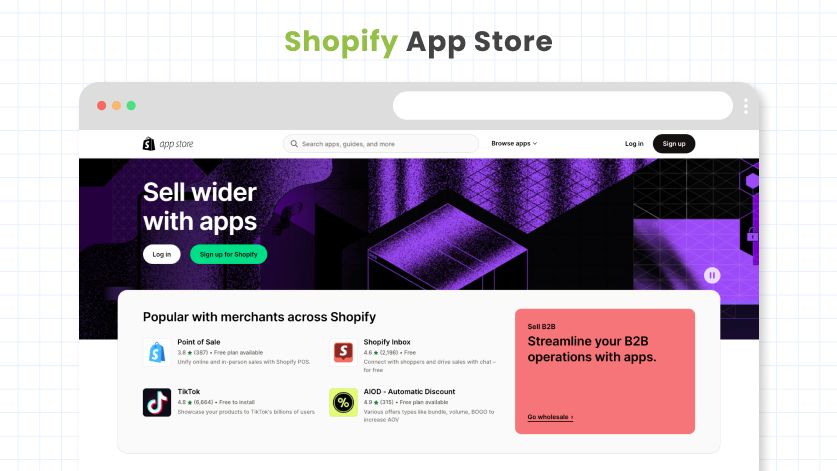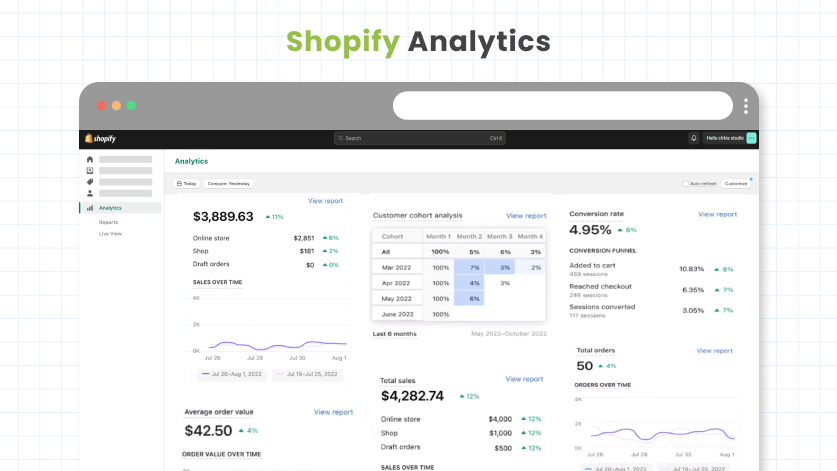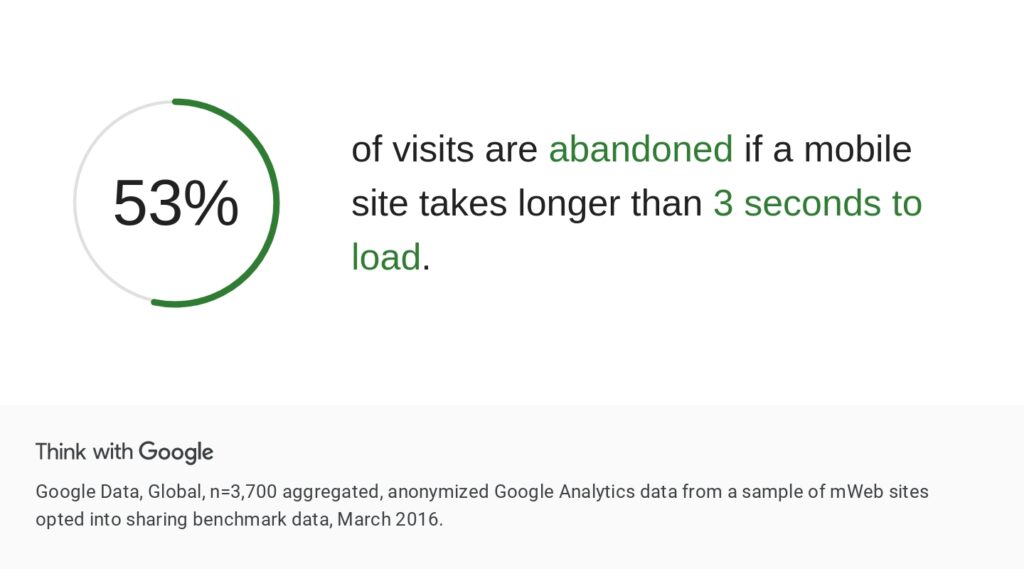Are you ready to join the profitable world of eCommerce? Now you have access to a comprehensive suite of tools and services through Shopify Online Shopping, allowing entrepreneurs to streamline their operations and run their businesses quickly.
This ultimate guide was crafted with business owners in mind, providing valuable insights, strategies, and tips to help you establish and grow a successful online store using the Shopify online shopping platform.
From setting up your shop to optimizing the shopping experience, marketing your products effectively, and understanding how customer analytics can increase conversions, we cover it all.
Ready for take-off? Get out there and unlock the full potential of Shopify!
Why Use Shopify for Online Shopping?
There are many benefits of using Shopify for your online shopping:
- User-Friendly Interface: Shopify’s platform is designed to be easy to use, even for beginners.
- Customizable Templates: With over 100 free and paid templates to choose from, you can design a store that fits your brand and style.
- Wide Range of Features: Shopify offers a wide range of features to help you manage your store, from inventory management to shipping and fulfillment.
- Integration with Third-Party Apps: Shopify integrates with a variety of third-party apps to help you enhance your store’s functionality.
- Secure Payment Processing: Shopify offers secure payment processing options, including Shopify Payments and third-party gateways.
Getting Started with Shopify Online Shopping:
In the digital world of today, it’s almost necessary to have a strong online profile. Not only does it provide you with free advertising, but it also gives you an advantage over your competitors.
As one of the most successful eCommerce platforms, Shopify makes it easy for people and businesses to set up their own online stores.
Whether you’re a new business owner or have been in business for a while, this guide will take you through the steps you need to set up your Shopify store and start selling online.
1. Create a Shopify account:
- On the Shopify.com page, click the “Start free trial” button.
- Create an account by giving your email address, password, and shop name.
2. Customize Your Online Store:
- Give your store a name and URL that are unusual and easy to remember.
- Change settings like the unit of measure, time zone, and currency to fit the needs of your target group.
- Choose a theme that fits the style of your brand and make it your own by adding your branding elements.
3. Insert Products in Your Online Store:
- Go to the “Products” tab in your Shopify account after signing in.
- Click “Add Product” and fill in the important information, such as the title, description, price, and images.
- Sort your goods into groups or categories to make them easier to find.
4. Set up Choices for Payment and Shipping:
- Connect your Shopify online store to different payment methods so it can accept credit cards, PayPal, Apple Pay, and more.
- Set up shipping settings, such as figuring out shipping rates, integrating with shipping carriers, and handling fulfillment processes.
After completing these steps, your Shopify online store will be ready to display your products and provide your customers with an enjoyable online shopping experience.
Shopify Online Shopping Features:
Shopify offers a comprehensive set of online shopping features that enable businesses to provide engaging and seamless shopping experiences to their customers.
Here are some key features:
1. Shopify Point of Sale (POS) System:
The Shopify Point of Sale (POS) system is a powerful tool that allows businesses to easily connect their online and offline sales platforms.
Retailers can use this tool to accept payments in person, keep track of their inventory, and share information across all their sales platforms.
Here are Some Ways that the Shopify POS System Improves Shopify Online Shopping:
1. Take Different Kinds of Payments: With Shopify POS, businesses can take cash, credit cards, and mobile payments, among other things. Customers find it easy and quick to check out.
2. Streamlined Inventory Management: Use Shopify POS’s unified inventory management features to make sure that your online and physical stores always have the right amount of stock. Get alerts when your stock is low, and it’s easy to find things you have too much of so you can change the price or get rid of them.
3. Better Customer Profiles: With Shopify’s unified customer profiles, businesses can learn more about each customer, like what they’ve bought in-store and online. Use this knowledge to target your marketing efforts and get to know your customers better.
4. Efficient Order Fulfillment: Order delivery is easier with Shopify POS because it combines online and offline sales into one system. Handle orders without having to switch between screens and improve the product splitting and shipping processes to make order completion faster and more accurate.
5. Powerful Analytics and Reporting: With Shopify POS’s powerful analytics and reporting tools, you can find out a lot about how your business is doing. Analyze your sales data, trends in how customers act, and inventory measures to make decisions based on data and improve your operations and marketing strategies.
2. Shopify Payment Gateway:
The built-in payment gateway in the Shopify store is intended to make transactions easier for both customers and businesses. It has a number of exceptional qualities, such as:
1. Multiple Payment Options: Companies can offer different payment options to their customers, such as credit cards, wallets, and other methods. Customers can pay in the manner of their choice thanks to this, and it also gives businesses the freedom to adjust to shifting consumer preferences.
2. Secure Transactions: Shopify places a high priority on security and compliance, providing highly secure and dependable transaction processing supported by advanced fraud detection mechanisms and industry-standard encryption techniques.
3. Built-in Payment Processing: Shopify’s integrated system eliminates the need for external payment processors, streamlining the payment process and giving businesses a single platform to control orders and payments.
3. Shopify App Store:

The Shopify App Store is an important part of the Shopify ecosystem because it provides businesses with additional eCommerce options.
Here are a Few Important Things to Know About the App Store:
1. Wide Selection of Apps: The Shopify App Store has more than 8,000 apps for discounts, shipping rates, marketing, sales optimization, inventory management, and customer help, among other things.
2. Faster: Using specialized apps from the App Store, businesses can improve the speed of their online stores. These apps have strong features that don’t need complicated development or coding, like integrating with social media platforms or making email campaigns that people want to read.
3. Trusted and Reliable Solutions: Apps in the Shopify App Store go through a full review process to make sure they meet Shopify’s high standards for quality. This makes sure that everything works together and is safe, which lowers the chance of problems.
4. Scalable and Flexible: The apps in the Shopify App Store are designed to be scalable and flexible to keep up with business growth. Businesses can find apps that meet their changing needs, whether it’s to handle more sales, enter new markets, or connect with systems from other companies.
4. Shopify Abandoned Cart Recovery:
Online shops face a big problem when people leave items in their shopping carts. The Abandoned Cart Recovery tool from Shopify is a good way to get back lost sales and increase conversion rates.
First, Let’s Look at How it Works Shopify Abandoned Cart Recovery:
1. Understanding Abandonment: When a customer adds items to their shopping cart but doesn’t finish the buy, they have “abandoned” their cart. This can happen for a number of reasons, like being distracted, getting a bill you didn’t expect, or getting confused at the checkout.
2. Shopify’s Lost Revenue Fix: With Shopify’s Abandoned Cart Recovery, sellers can use automated follow-up emails to get in touch with buyers who gave their contact information but didn’t complete their purchase.
This feature saves what’s in the customer’s cart and lets them send personalized emails with pictures of the things they left behind, along with deals and other incentives to get them to buy them.
3. Setting up Automated Email Campaigns: Shopify online shopping lets businesses set up multiple email campaigns that target buyers who left their carts behind. These programs start on their own at times that have already been set. This makes sure that sales are recovered regularly and effectively.
4. Customizing Cart Reminders: With Shopify’s online store, businesses can change when and how often cart reminder texts are sent. This gives them the freedom to match the number and timing of texts to how customers act, which increases the likelihood of successful conversions.
5. Tracking Performance with Analytics: Shopify’s Abandoned Cart Recovery tool gives detailed analytics on key metrics such as total revenue, customer interaction, and recovery rates. With this data, companies can look at how well their marketing strategies are working and decide how to improve them.
By using Shopify’s Abandoned Cart Recovery, businesses can deal with the problem of carts being left behind, reconnect with possible customers, and increase the number of sales that are made.
If you want to reduce the cart abandonment rate with an automatic discount here is the complete guide on how to reduce cart abandonment rate.
5. Shopify Online Store Email Marketing:
Email marketing is a way for businesses to reach people and make more sales. With Shopify’s Email Marketing tool, it’s easy for businesses to create email campaigns that look professional and send messages that are tailored to different groups of customers.
Let’s look at how this feature makes it easier to make interesting email material, builds relationships with customers, and helps increase sales of the Shopify store.
1. Simplified Campaign Creation: To make a powerful email campaign, you no longer need to buy expensive tools or know how to code.
Shopify’s Email Marketing feature makes the process easier with an easy-to-use interface and ready-made templates that can be quickly customized with images, product information, special deals, and other content elements.
2. Targeted Messages: Personalized messages are important for good contact, but it can be hard and take a lot of time to make custom content for each customer.
With Shopify’s Email Marketing, businesses can divide their customer lists into groups based on things like purchase history, demographics, or level of involvement. This way, customers get useful emails that are made just for them.
3. Streamlined Communication: With Shopify’s Email Marketing tool, businesses can use automated email sequences to save time and respond quickly to client questions without having to write each message by hand.
By setting up prompts, like sending a welcome email to new users or a birthday greeting, business owners can make sure that the right emails are sent automatically at the right time.
By sending texts at set times and days, scheduled promotions also make it easy for businesses to stay in touch with their customers.
4. Insightful Performance Tracking: Shopify’s Email Marketing feature lets businesses use performance measures and data to track how well their email campaigns are doing.
You can learn a lot about how well your email marketing is working from key measures like read rates, click-through rates, and conversion rates.
By looking at these metrics, businesses can make choices based on data, improve their messaging strategies, and keep making their email marketing campaigns more effective.
6. Shopify Analytics:

A key part of a good plan for eCommerce is the study of data. Shopify Analytics gives businesses a number of tools to help them make smart decisions and grow as much as possible.
Let’s Look at How it Can Help you Grow Your Shopify Online Store:
1. Comprehensive Data Reporting: Shopify Analytics gives you access to thorough reports that tell you useful things about how your store is doing.
These reports cover a lot of different things, like sales, orders, customers, and product measures like revenue, conversion rates, average order value, and user acquisition.
By reading these reports carefully, you can learn a lot about the overall health of your online business and find ways to make it better.
2. Real-Time Monitoring: Shopify Analytics shows you important data like sales, traffic, and conversion rates in real-time. This tool lets you see how your store is doing right now and keep up with current trends.
If you can get to important information right away, you can act quickly on opportunities and solve problems as they come up. This helps you stay open in an eCommerce world that changes quickly.
3. Customizable Dashboards: Shopify Analytics lets you use user-defined data to make graphs that are unique to your business and match its goals.
You can quickly get to the most important parts of your business operations by using tools that you can change and that help you filter out unimportant info.
4. Advanced Filtering and Segmenting: Shopify Analytics lets businesses dig deeper into their data and divide it into groups based on things like customer demographics, buying habits, or product types.
This helps businesses figure out which groups of customers bring in the most money or need focused marketing so they can make good plans.
5. Integrations with Different Marketing Channels: By integrating with various marketing channels such as display ads, email marketing, social media, and more Shopify Analytics makes it easy to manage all your marketing efforts.
You can see how well your work is going and make sure your money is being spent wisely.
Optimizing Your Shopify Online Shopping Experience:
Here, we’ll look at some of the best ways, based on data and best practices from the industry, to improve your Shopify online shopping experience.
1. User Interface: According to the study, show that 88% of online shoppers are less likely to go back to a website where they had a bad user experience.
Focus on making a design that is easy to use to make users happy and boost sales. To make it easy for customers to shop, make access easier, make sure goods are grouped in a way that makes sense, and use design elements that are clear and look good.
2. How to speed up the loading speed of your site: How happy your customers are and how many of them you convert depends directly on how quickly your site runs. According to Google, shows that 53% of shoppers leave a website that takes more than three seconds to load.
You can make your Shopify online store open faster by making images smaller, using caching techniques, and using a reliable hosting source. A faster loading time will keep buyers excited and make it more likely that they’ll buy something.

3. Putting the Best SEO Practices into Place: Search engine optimization (SEO) is one of the best ways to get people to visit your Shopify online store without paying for ads. 53% of page traffic comes from organic search, according to research.
Put important terms in your product descriptions, meta tags, and URLs to help search engines find your store. You should also focus on getting good backlinks and putting out useful content if you want to improve your SEO.
4. Adapting your site for mobile devices: Mobile commerce is on the rise, and 54% of all eCommerce purchases are made on mobile devices.
Make sure your Shopify online store works well on mobile devices by using a flexible design, adjusting page layouts for smaller screens, and letting customers check out easily from their phones.
If your site is easy to use on mobile devices, you’ll make more sales. People who shop on their phones, which is becoming more and more common, will like this.
5. Using social media for marketing: Social media sites are great ways to market your Shopify online store and reach more people. According to Hootsuite, show that 54% of people who look for goods on social media do so on social sites.
Make content that people will want to share, run targeted ad campaigns, and add “share” buttons to your product pages to use social media marketing.
This will help more people recognize your name and visit your Shopify online store, which will increase your chances of making sales.
Managing Your Shopify Online Store:
Having an online store means you have to do a lot of important tasks that have a direct effect on how well your Shopify business does.
The key to making sure things run easily, and customers are happy is good management. This includes receiving orders and returns and figuring out how well sales are going.
Here, we’ll Talk About Some of the Most Important Parts of Using Shopify to Run an Online Store:
1. Handling Orders and Returns: It’s important to handle orders and returns well so that the customer experience goes smoothly. Shopify online shopping data shows that 35% of people who buy things online expect to see more than one way to pay at checkout.
Streamline the way you fill orders by managing order alerts, tracking shipments, and giving customers different ways to pay. Also, make sure your refund policies are clear, and that refund requests are treated quickly to build trust and make customers happier.
2. Keeping Track of Inventory: It’s important to keep track of inventory so that you can meet customer needs and avoid running out of stock.
A study shows that 47% of online shoppers expect the items they want to buy to be in-store. Use Shopify’s inventory management tools to keep track of stock levels, set up automatic alerts when stock is getting low, and keep stock in sync across multiple sales platforms.
If you know how to handle your inventory well, you can fill orders quickly and keep a wide range of products on hand.
3. Customer Service and Communication: If you want people to come back, you have to treat them well. Research has shown that 86% of people are ready to pay more for a better customer experience.
The Shopify online store makes it easy to talk to customers by giving you tools like live chat, email help, and robots.
To make people happy and keep them coming back, you should answer their questions quickly, help them in a friendly way, and talk to them in a clear and helpful way throughout the buying process.
4. Evaluating Sales and Performance: If you want to make good business choices, you need to look at your sales and performance data often.
With Shopify’s analytics tool, you can look at key success indicators like conversion rates, average order value, and the cost of getting a new customer.
Use these lessons to figure out where you can improve, how you can change your marketing strategies, and how you can make your goods better so you can sell more and make more money.
5. Changing your Shopify Online Store Plan: As your business grows, you may want to change your Shopify plan to get access to more advanced features and expand the options of your store.
Shopify online shopping has plans that can be changed to fit the needs of different businesses. When a business switches to a higher-tier plan, its average income goes up.
Look at what your business needs and the extra features that come with upgraded plans. Then, make a choice based on what you’ve learned to open up new growth opportunities.
Shopify Online Shopping Success Stories:
Do you know that Shopify Success Rate of eCommerce stores is around 5% to 10%. This means that out of every 100 businesses that use Shopify, only about 5 to 10 businesses of them are successful.
Shopify online shopping has helped a lot of great online stores get started, and two case studies show how the platform can be used to grow and try new things.
Asphalte is a line of clothes that came out for the first time in 2016. It does business in a unique way that is called “pre-order”.
They built a system around the customer by making clothes based on what the customer wants without charging anything upfront. With this method, Asphalte was able to make high-quality products that buyers liked and that were easier on the environment.
By working with top manufacturers and using online polls to get customer feedback, Asphalte made customers a part of the process of making its products.
The Shopify online store was a big part of Asphalte’s success because it helped them make an attractive website with guest surveys and use beautiful popup themes to get people to fill out the surveys.
Denise Woodard started Partake Foods, which is another great example of a successful business. Woodard started her own packaged goods business because her daughter had severe food allergies, and she didn’t have many choices.
After 86 people turned her down, she got the money she needed and built a Shopify store. Focusing on making high-quality goods and building an email list, Partake Foods grew by a factor of ten and made more than $4 million in sales in 2020 alone.
Woodard worked hard to build an email list and use online marketing tools like Google ads and ads on social media to help his business do well.
People Who Own Shopify Stores Can Learn a Lot From These Stories of Success:
- First, putting customer feedback and tastes into the process of making new products can help build trust and boost sales. If businesses listen to their customers, they can make goods that sell well and meet their needs.
- Second, making and taking care of an email list is a powerful way to keep growing and keep customers excited. Shopify has easy-to-use tools and features that can be used to get email addresses from users, like customized popups. By using these tools and offering rewards like discounts, brands can grow their email lists and get more people to buy.
Common Challenges and Solutions:
Business owners have to deal with a number of problems that can slow down growth and profit if they want to run a successful Shopify store.
These problems can be fixed by implementing the right plans and answers. In this section, we’ll talk about some of the most common problems Shopify store owners have, give you helpful tips on how to solve them, and show you how to make sure your eCommerce business does well.
1. Common problem: One common problem is that there aren’t many ways to change Shopify themes, which makes it hard for store owners to build a unique brand personality.
You can solve this problem by using one of the best Shopify themes available in the Shopify Theme Store. You might want to hire a Shopify expert or developer to change the style to fit your needs.
Use the apps and tools that come with Shopify to make your store run better and give you more ways to change it.
2. Low Website Traffic: Low traffic on the internet is another problem that many store owners have to deal with. Optimize your store for search engines with a strong SEO plan to get more traffic and attention.
To get the word out about your business, use content marketing, social media events, and partnerships with people who have a lot of influence.
Use paid advertising, email marketing efforts, and partnerships with brands that work well together to bring the right people to your store.
3. Cart Abandonment Rate: Cart abandonment is a regular issue that can cause sales opportunities to be lost. To avoid this, you should improve your checkout process by reducing friction and making it easier to follow the steps needed to complete a purchase.
Customers will be more likely to buy from you if they can choose to check out as a “guest”, you use trust signs, and your shipping and return policies are clear. Use automated email campaigns to let customers know about carts they’ve left behind and offer benefits to get them to finish shopping.
4. Inventory Management: Keeping track of the stock is a key part of making sure things run smoothly. Use inventory management apps and tools from the Shopify App Store to keep track of and control your stock.
Set up automatic alerts when stock is getting low so that more can be ordered on time. Use information about past sales and tools for making predictions to make sure you have the right amount of things and don’t run out or have too much.
5. Scalability: As your Shopify online store gets bigger, it can be hard to keep it running well and grow it. Review your site often and make changes to make it faster and better.
Consider upgrading to a higher-level Shopify plan with more tools and resources to handle more visits and sales. Make sure your store works well on mobile devices so that you can serve the growing number of people who shop on their phones.
6. Maintaining Customer Relationships: For long-term growth, you need to keep your customers. Set up a plan to keep customers that includes personalized email marketing campaigns, reward programs, and deals that are only sent to customers who have already bought from you.
Give people great service, talk to them on social media, and ask for feedback to build long-lasting relationships and loyalty.
7. Security: For trust and reliability to stay strong, security and stopping scams are important. Enable SSL security on your store to ensure safe transactions.
Use Shopify’s built-in tools for analyzing fraud and connect with reliable payment platforms that have advanced tools for finding and stopping fraud.
Keep up with the latest best practices for security and keep an eye on your store for anything out of the ordinary.
By using these tips and answers, you can solve problems that most Shopify online store owners have and set yours up for success.
Overall, the Shopify store setup comes with its fair share of challenges. From choosing the right theme and optimizing product descriptions to navigating complex integrations and marketing strategies, there are several pitfalls to avoid.
A critical mistake is obviously to neglect proper planning and research before launching your store. Failure to define your target audience, conduct a competitive analysis, and establish a solid marketing plan can hinder your chances of success.
However, with meticulous preparation, attention to detail, and a willingness to learn from others’ experiences, you can overcome these challenges and lay a strong foundation for a thriving Shopify store.
Remember, a well-prepared and strategically executed Shopify store can significantly increase your prospects for long-term success.
If you want to compare which is better for my eCommerce store here is the full comparison on BigCommerce vs. Shopify
Future of Shopify Online Shopping:
As the eCommerce industry continues to change quickly, it’s important for the success of your Shopify online store to keep up with new trends and stay ahead of the competition.
In this article, we’ll look at what is the future of eCommerce, talk about new and planned Shopify online shopping features, and talk about how you can keep your footing in a shopping world that is always changing.
Predictions for the Future of Ecommerce:
1. Mobile eCommerce: Predictions say that the share of all eCommerce sales that come from mobile shopping will continue to grow. This means that Shopify online store sellers need to make mobile optimization their top goal, make it easy for customers to check out, and focus their design strategies on mobile shoppers.
2. Personalization and AI: Thanks to Artificial Intelligence (AI) and machine learning, stores will be able to offer campaigns and tips that are right for each customer. Customers will have a better time as a result. If you want to stand out from your competitors, use tools and technologies that are driven by AI.
3. Augmented Reality and Virtual Reality: AR and VR will change the way people shop online by giving them more engaging and involved experiences.
For example: Merchants could use augmented reality (AR) to show off their goods or virtual reality (VR) to let customers try on clothes digitally. This would increase customer engagement and happiness.
New and Upcoming Shopify Online Shopping Features:
Shopify online shopping is always getting better and adding new ideas and features to help businesses and make online shopping better. In the most recent Winter ’23 edition, Shopify showed off an amazing list of over 100 product changes that keep sellers at the top of eCommerce.
With these changes, you can do fun things like using 3D models to make products more interesting, adjusting dynamic checkout buttons to make transactions go more quickly, and using location priority settings to manage your inventory in a more advanced way.
The Shopify online store has also added new tools that make the user experience even better. With built-in video chat and more multi-currency options, it’s easier to sell around the world.
Better disability features make sure that everyone can use the software. The Shopify Sustainability Fund, which gives businesses the tools they need to help the world in good ways, is another example of Shopify’s commitment to sustainability.
Shopify online shopping is dedicated to giving merchants the tools they need to succeed in the competitive world of eCommerce and give their customers great shopping experiences.
These current and planned features show that commitment. The Shopify online store keeps its image as a reliable and forward-thinking eCommerce platform by staying on the cutting edge of new technologies and green initiatives.
Also, do you know why Shopify owners are switching to Shopify online store 2.0? Here is the complete guide on Shopify online store 2.0.
How to Stay Ahead of the Competition?
As eCommerce gets more and more competitive, it’s important to find ways to stay ahead of the game and stay in the game. Here are three important ideas:
1. Adopt Omnichannel Selling: To reach customers no matter where they are, make sure all shopping sites offer the same experience. Integrate your Shopify online store with other marketplaces, social networks, and real shops so you can reach all possible customers.
2. Use Data and Analytics: Shopify’s data analytics tools and third-party connections can give you useful information about customer behavior, sales trends, and how well your marketing is working. With this information at your fingertips, you’ll be able to help your business grow by making better choices.
3. Focus on Sustainability: As more people become environmentally conscious when shopping online, sustainable eCommerce practices are a great way to stand out from the crowd and gain loyal customers who love what you’re doing for the world.
Think about selling eco-friendly products or using boxes that can be recycled. It’s a good use of your time to talk about your green efforts on your Shopify shop.
Conclusion:
In conclusion, this guide has given an in-depth look at Shopify and everything it has to offer eCommerce business owners. We have talked about Shopify’s features, such as its powerful payment methods, the App Store for adding more features, abandoned cart recovery, email marketing, analytics, and more.
Also, talked about the best ways to create a successful sales strategy and build a brand profile. We also gave tips on how to sell on Instagram, shared solutions to common problems that businesses have with Shopify, and looked at upcoming changes to the platform.
As you move forward with your Shopify eCommerce business, keep this guide handy for the tips and tools it gives you to help you reach your goals.
Also, don’t be afraid to contact us at Cirkle Studio if you have any questions or need help putting up your store. We’re here to help!








